
A cart or dray is a vehicle designed for transport, using two wheels and normally pulled by one or a pair of draught animals. A handcart is pulled or pushed by one or more people.
A limber is a two-wheeled cart designed to support the trail of an artillery piece, or the stock of a field carriage such as a caisson or traveling forge, allowing it to be towed. The trail is the hinder end of the stock of a gun-carriage, which rests or slides on the ground when the carriage is unlimbered.
A gun carriage is a frame and mount that supports the gun barrel of an artillery piece, allowing it to be maneuvered and fired. These platforms often had wheels so that the artillery pieces could be moved more easily. Gun carriages are also used on ships to facilitate the movement and aiming of large cannons and Guns.These are also used in the funeral procession of any higher authority of any state and country.

A horse-drawn vehicle is a mechanized piece of equipment pulled by one horse or by a team of horses. These vehicles typically had two or four wheels and were used to carry passengers and/or a load. They were once common worldwide, but they have mostly been replaced by automobiles and other forms of self-propelled transport.

The Mortier de 280 TR Modèle 1914 Schneider was a French siege howitzer manufactured by the Schneider et Cie company, used during World War I. The howitzer had its origins from a Russian Army policy to upgrade its artillery park after the poor showing of Russian artillery in the 1904-5 Russo-Japanese war. In 1909 an agreement was signed between Schneider and the Russian armaments manufacturer Putilov to jointly develop and produce a number of artillery types. One of these types was a 279.4 mm (11-inch) siege howitzer with a range of 6,000 m (20,000 ft) to replace very old Russian guns of similar calibre. Schneider delivered the first prototype of the siege howitzer to the Russians in 1912 for extensive testing. Although the Russians found the gun was unable to penetrate the heaviest reinforced concrete fortifications its general performance was judged satisfactory which led to an order for 16 howitzers to be delivered in 1915. The French Army expressed interest in the Schneider howitzer as a possible replacement for the Mortier de 370 Mle 1885 De Bange. After some dithering by French authorities 18 howitzers were ordered in 1913. Delivery of the howitzers to Russia and France was delayed by the general mobilisation of 1914 which disrupted industrial production. During the war 126 howitzers were delivered to the French Army and 26 to Russia as the 280 mm Schneider Mortar Model 1914/15 before the 1917 revolutions. In addition another 25 barrels were installed post-WW1 on the Saint-Chamond heavy self-propelled gun chassis as the Mortier 280 mm TR de Schneider sur affût-chenilles St Chamond.
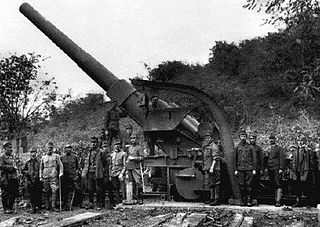
The 24 cm Kanone M. 16 was a super-heavy siege gun used by Austria-Hungary during World War I and by Nazi Germany during World War II. Only two were finished during World War I, but the other six were completed in the early twenties and served with the Czechoslovak Army until they were bought by the Germans after the German occupation of Czechoslovakia in 1938. During World War I, one gun served on the Western Front and the other on the Italian Front. During World War II, they saw action in the Battle of France, Operation Barbarossa and the siege of Leningrad.
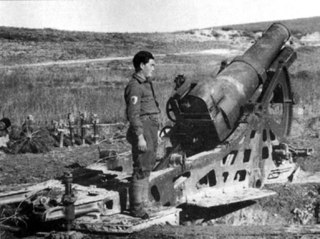
The Mortaio da 260/9 Modello 16 - was an Italian Heavy mortar and Siege Gun designed by the French Schneider Company and produced under license in Italy by Ansaldo and Vickers-Terni for the Italian Army. It was used by the Italian Army during both the First World War and Second World War.

The Canon de 19 C modèle 1875 was a coastal defense gun designed and built in the 1870s. A number of guns were also converted to railway guns during World War I in order to meet a need for heavy artillery.

The Canon de 370 modèle 75/79 Glissement was a French Railway gun designed during World War I but produced too late to see action during the war. The six guns built were held in reserve between the wars and were not mobilized by France during World War II.

The 21 cm Mörser 99 was a German siege mortar built by Krupp which served during World War I. The mortar utilized a new nickel-steel alloy of greater strength than other cast cannons, though it lacked a recoil mechanism. While the gun was more effective than previous models, it was soon phased out because of improved field artillery and counter-battery fire, though it remained in service in limited numbers throughout the war because of heavy German losses.
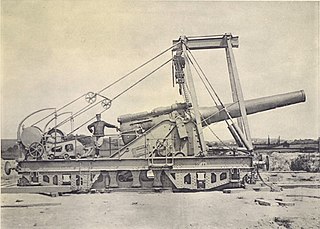
The Canon de 240 TR Mle 1903 sur affût-truck Mle 1914 was a French railway gun and siege gun used by the French Army during World War I.

The Obusier de 200 "Pérou" sur affût-truck TAZ Schneider was a French railway gun built before and served throughout the First World War. It was one of the first French railway guns mounted on a standard gauge rail car during the First World War.
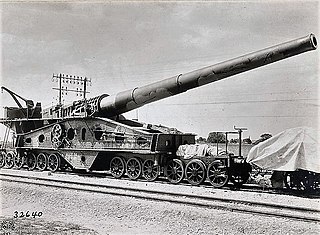
The Canon de 340 modèle 1912 à berceau was a French railway gun used by the French Army and the United States Army during World War I. The guns were used again by the French Army during World War II.

The Canon de 340 modèle 1912 à glissement was a French railway gun designed during World War I but produced too late to see action during the war. The six guns built were held in reserve between the wars and were mobilized by France during World War II.
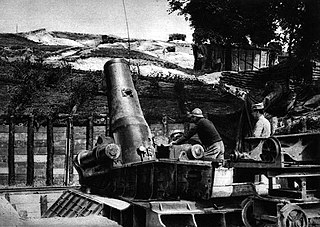
The Mortier de 370 modèle 1914 Filloux (MLE) was a siege mortar. It was designed before the First world war and was used during the First world war.
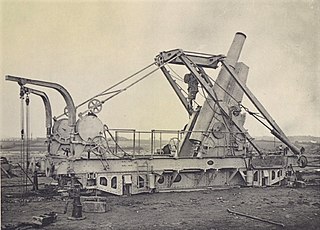
The Mortier de 293 Danois sur affut-truck modèle 1914 was a French railway gun and siege gun used by the French Army during World War I and World War II.

The Canon de 340 modèle 1893 à glissement was a French railway gun designed in 1916 that saw action during the First world war and Second world war.

The 120 mm Armata wz. 78/09/31 and 120 mm Armata wz. 78/10/31 were field guns produced in Poland and used by Poland during World War II and Finland during the Continuation War.

The Peigné-Canet-Schneider mle 1897 gun carriage was a railway gun carriage designed and built during the late 1800s. Two types of guns were mounted on these carriages and both the French Army and US Army used them during World War I. They were retired soon after World War I.
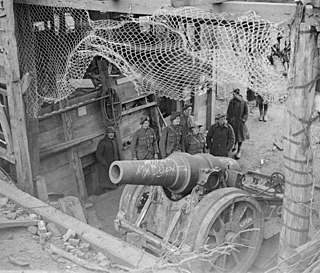
The 21 cm Haubitze M1891 or (21 cm Howitzer Model 1891) in English was a fortress gun built by Krupp that armed the forts of several European countries before World War I. Two countries that bought the M1891 were Belgium and Romania. In Belgian service it was designated Obusier de 21c.A. and in Romanian service it was designated Obuzierul Krupp, calibrul 210 mm, model 1891.
This page is based on this
Wikipedia article Text is available under the
CC BY-SA 4.0 license; additional terms may apply.
Images, videos and audio are available under their respective licenses.


















